
Biology, 24.04.2020 08:39 ryanbransky
You will create a molecular clock model for an arthropod gene. Follow these guidelines to make your model: Your timeline will span from 90 million years ago to the present. The common ancestor in your model is an arthropod that lived 90 million years ago. The gene that you’ll track codes for a protein in the species’ venom. The DNA sequence you’ll track contains 10 nitrogen bases. You can choose the order of the bases and where the mutations occur. This gene mutates at a rate of approximately 0.76 base pairs every 17.1 million years. To build your model, calculate the estimated time period it takes for 1 base pair to mutate. The first time period will only show the common ancestor. At the beginning of the second time period, three lineages will diverge from the common ancestor, each with a different mutation in their gene sequences. The first and third descendant species will survive for the rest of the timeline. The second descendant species was extinct 50 million years ago. Calculate how long it will take for one full base pair mutation to occur. Explain your reasoning by constructing a mathematical equation.

Answers: 1


Other questions on the subject: Biology


Biology, 21.06.2019 15:00, hann647
Always use significant figure rules. remember that these rules apply to all numbers that are measurements. if a vector that is 3 cm long represents 30 km/h, what velocity does a 5 cm long vector which is drawn using the same scale represent? a.100 km/h b.60km/h c.50km/h
Answers: 2


Biology, 22.06.2019 02:00, Yskdl
Consider the motion of the balloon and its air contents in terms of momentum. in step 1 above, the total momentum of the balloon and its contents was zero. recall that momentum = mv. both the balloon and the air inside it had a velocity of zero and therefore the total momentum was zero. now think about what happened when the air escaped from the balloon. a certain mass of air accelerated in one direction. in order to keep the total momentum of the system zero, the balloon itself (which has mass) had to accelerate in the opposite direction. use this scenario to you explain why the soda can rotates when the water squirts out of the escape holes. what was your hypothesis concerning the water-filled can? according to your data, do you think your hypothesis was correct? (be sure to refer to your data when answering this question.) summarize any difficulties or problems you had in performing the experiment that might have affected the results. describe how you might change the procedure to avoid these problems. give at least one more example of newton's third law in everyday life.
Answers: 1
You know the right answer?
You will create a molecular clock model for an arthropod gene. Follow these guidelines to make your...
Questions in other subjects:







Mathematics, 23.07.2020 01:01

English, 23.07.2020 01:01





